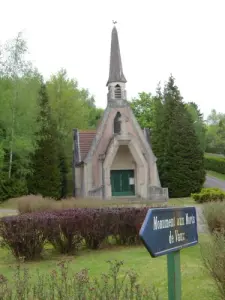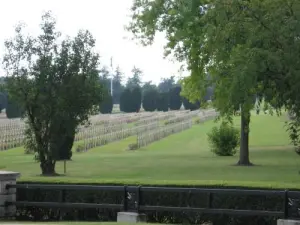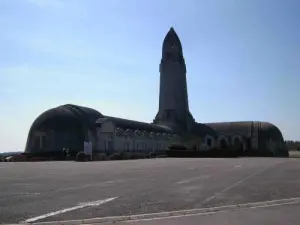13 km east of Charny - 11 km north-east of Verdun.
Particularity: Vaux-devant-Damloup is the only one of the 9 destroyed destroyed villages.
Vaux-devant-Damloup is a village destroyed apart because, being on the edge of the "red zone" it was able to rebuild, over time, a new small village, very close to the old destroyed village which presents the same characteristics as his eight companions in misfortune.
Belonging to the Chapter of Verdun before the Revolution, it has always been a prosperous village in the course of its history.
The presence of Fort de Vaux nearby has always jostled the course of the history of the village. Indeed, since its construction from 1881 to 1884, the village was widely solicited to participate in the accommodation of the many workers taking turns there; as well as during the major reinforcement work undertaken on Fort from 1888 to 1912.
In 1915, the decision of the staff, aimed at disarming in part all Forts, transfers the defensive effort especially to the villages. Thus, that of Vaux, placed in the North of his Fort and in contact with the plain of Woëvre, becomes naturally an important point in the defense device of the entrenched camp of Verdun.
During the great German offensive, launched at the end of February 1916, it was one of the major objectives of the Germans after the capture of Douaumont, which fell on March 2, and before that of Fort de Vaux.
After bitter fighting in its walls, the village falls to the German hands on March 31, 1916.
The French bombardments of April then succeed the German bombing of March, only accentuating the outright annihilation of the village.
After the fall of the village, the 50th German Division is eager to seize Fort de Vaux which resists heroically from June 2 to 7, 1916 under the command of Commander Raynal. This tragic episode becomes a feat of arms forever famous, because the garrison, running out of drinking water and fighting in the galleries of the Fort for days, ends up surrendering to the Germans who, admiring the valor of the hairy survivors, decide to pay them the military honors when they leave the fort.
In 1918, the village of Vaux-devant-Damloup is found within the limits of the famous "red zone" prohibiting any reconstruction.
In 1919, it was also part of the list of destroyed villages and, during the interwar period, the monument to the dead was erected along with the Saint Philippe and Saint-Jacques chapel, just like the eight others. villages destroyed.
However, its position at the edge of the zone and the presence of the railway of the Eastern Railway Company, which obtained the authorization to house its ten service agents on the site of Vaux-devant-Damloup, allows the village to find, over the years and since the two wars, a new life, now very active, looking to the future and including the Internet, without denying the tragic past of the destroyed village, always present at his door and in memory of his 70 inhabitants.
7 km east of Charny - 11 km north-east of Verdun.
Created in the Gallo-Roman era, the village of Douaumont had, until 1884, a simple and peaceful rural life on its heights dominating both the plain of Woëvre in the East and the Meuse valley in West.
From 1885, its 192 inhabitants suddenly pass to 576 with the arrival of a large number of earthwork workers, mainly Italian, responsible for the construction of Fort Douaumont. This influx of people will allow the development of many small businesses that will contribute to a real prosperity of the village.
On the eve of the war of 14-18, it still has 288 inhabitants including many soldiers.
During the year 1915, the French staff no longer believes in the effectiveness of the protection of Forts in the face of the arrival of new types of ammunition like the torpedo shell which proved its effectiveness at the beginning of the war against Belgian Forts and decides to disarm some of its Forts including that of Douaumont.
During the great German offensive of February 1916, Fort Douaumont remains a serious and symbolic goal for the German General Staff who seize 25 February without having to really fight.
In contrast, the village of Douaumont itself suffered a powerful bombardment and murderous assaults from late February to March 2, 1916 and falls at the same time as many hairy and French officers.
It was during this fight that Captain Charles de Gaulle, commanding a company of the 33rd RI, was wounded and taken prisoner in Germany until the end of the war.
On March 4, 1916, the entire village of Douaumont in ruins, as well as his Fort, are in the hands of the Germans and are now subject to the constant bombardment of French cannons.
The Fort, occupied by many Germans, knows, on May 8, 1916, a violent explosion of a deposit of grenades and flamethrowers, hit by a shell. This explosion kills more than 800 German soldiers. But not being able to bury them all near the Fort, the German command decides to wall 679 bodies in a gallery of the Fort which, still today, remains the only German necropolis on Verdun.
October 24, 1916, the French army, launching a great offensive to the orders of the general Mangin, manages to reconquer the ruins of the village and the Fort thanks to the colonial troops of Morocco engaged on this sector of Douaumont which will remain French until the end of the war.
In 1919, Douaumont is part of the list of nine villages destroyed and the famous "red zone" where any reconstruction becomes prohibited.
However, the territory of the town of Douaumont will be chosen to accommodate, between the two wars, not only its monument to the dead in 1926 and chapel-shelter Saint-Hilaire, inaugurated in 1932, but especially the great national necropolis, created in 1925 and above which will be built and inaugurated, September 18, 1927, the impressive Ossuaire de Douaumont, initiated by Bishop Ginisty, bishop of Verdun, eager to bring one last remains more worthy to the remains of soldiers collected on the field of Battle of Verdun.
Douaumont and its ossuary became a symbolic place even stronger when, on September 22, 1984, MM. Kohl and Mitterrand, hand in hand, came to mark, in front of the ossuary, the reality of Franco-German reconciliation.
































